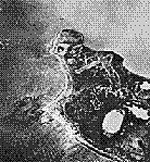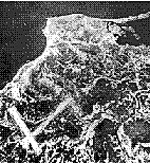The Soviet Pacific Fleet had its main base at Vladivostok, near the Korean border, inside the Sea of Japan. It was neither the strongest nor weakest of the Soviet Union's four fleets. Under the command of Admiral Yumashev (the final Kresta II-class cruiser would bear his name), its strongest ships were two modified Kirov (Project 26b) class cruisers, Kalinin and the Kaganovich (8100 tons standard, 9 x 180mm in 3 triple turrets, and 35 knots). The Fleet Escort Force consisted of one leader, the Leningrad class Tbilisi, and nine destroyers of the Type 7 class, plus one, Vnushitelnyy, of the Ognevoy class. There were also the two older destroyers Stalin and Voikov, variations of the WW I Novik, which had been something of a super destroyer in its era. These were only capable of 24 knots by 1945.
There were also four Uragan-class torpedo boats, and some four other escorts. Vorovsky was a 2100-ton converted private yacht donated to Russia in the First World War, and the NKVD operated two large patrol boats, Kirov (not to be confused with the cruiser) and Dzerzhinski (not to be confused with the Cold War-era Sverdlov-class cruiser.) These were the predecessors in some ways of the "Krivak III" class of the KGB Maritime Border Guard of the Cold War era. There were ten auxiliary minelayers of various sizes, the two most significant of which were the Okean and Okhotsk. These were former surveying vessels of 3200 tons, 264 x 42.5 x 18.5 feet, 14 knots, coal fired, with 3 x 130mm/50, 2 x 76.2mm/55 AA.
There were at least 8 Tral class (Project 59) minesweep-ers, plus some 21 minesweeping conversions, almost all from fishing trawlers or tugs in the 600 tons range. Some 78 Soviet submarines were also in the theater, including around 38 of the large "Shch" for "Shchuka" or "Pike", class and about 9 of the ocean-going "L" classes. The balance were among the earliest, least satisfactory of the coastal M (Malyy, "small") class boats. In size and potential these boats corresponded approximately to the German Type VII, Type IX, and Type II U-boat classes, respectively.
In addition to the US PT boats, there were as many as 150 Soviet-built motor torpedo boats, primarily of the G-5 type. Soviet Naval Aviation had numbers of MBR-2 flying boats & Il-4 bombers in the theater. The Soviet Air Force operated Yak-9 fighters and Il-2 (the "Sturmovik") ground attack aircraft. Further, US P-39 Airacobras and B-25 Mitchells supplied under Lend Lease were also in the Far East.
The next most important Soviet Naval base in the Far East was Petropavlovsk (na Kamchatkaya), near the tip of Poluostrov Kamchatkaya, the Kamchatka Peninsula. Kamchatka is part of the Ring of Fire, the chain of volcanoes that surrounds the Pacific Plate of our planet's plate tectonic System. At the extreme end of Siberia, even to this day there is no railroad line to Petropavlovsk ("Peter & Paul's town"). All supplies for the city must be brought in by ship or airplane.
But alone of all the ports of Russia, it opens into the broad Pacific, with no choke point obstructing it. As a result, during the Cold War it became the main base of the Soviet Pacific Fleet's ballistic missile submarines, with various supporting escorts. It was much less significant in WW II, but Kirov and Dzerzhinski, as well as large mine layer Okhotsk were based here, as well as many of the Lend-Lease vessels sent to the Soviet Union - of which more shortly.

 All three of the aerial recon photos on this page of Paramushiro were taken by a PV-1 on June 14, 1944. The PV-1 evaded multiple Zeroes, but of six other Venturas carrying out a diversionary airstrike, two were shot up by flak and had to land in Russia where they were interned, and the other four all had to have engine changes on their return due to excess power usage in outrunning fighters! All photos are USN.
All three of the aerial recon photos on this page of Paramushiro were taken by a PV-1 on June 14, 1944. The PV-1 evaded multiple Zeroes, but of six other Venturas carrying out a diversionary airstrike, two were shot up by flak and had to land in Russia where they were interned, and the other four all had to have engine changes on their return due to excess power usage in outrunning fighters! All photos are USN.Left: KarabuZaki
Right: Kashiwabara
Below: Kataoka
 The main Soviet effort when they entered the war against Japan was the defeat of Japanese forces in Korea and in Manchuria. The Soviets conducted a textbook blitzkrieg campaign in Manchuria, stunning the Japanese Army which had expected a more or less even fight. Soviet-era historians claimed that the shock of the Japanese Army's rapid defeat in Manchuria was of more importance than even the atomic bombs in causing Japan's surrender, while US historians often give this factor less credit than it deserves.
The main Soviet effort when they entered the war against Japan was the defeat of Japanese forces in Korea and in Manchuria. The Soviets conducted a textbook blitzkrieg campaign in Manchuria, stunning the Japanese Army which had expected a more or less even fight. Soviet-era historians claimed that the shock of the Japanese Army's rapid defeat in Manchuria was of more importance than even the atomic bombs in causing Japan's surrender, while US historians often give this factor less credit than it deserves.
The Soviet naval forces based at Vladivostok carried out operations on the Korean coast and in support of the flank of the Red Army's Operation August Storm - the conquest of Manchuria. They also supported operations against the Japanese-held southern half of Sakhalin Island, whereas forces from inside the Sea of Okhotsk supported the flank of the Red Army unit on the east side of Sakhalin. The forces at Petropavlovsk, however, carried out operations against the northern Kuriles.
More Operation Hula
-
Operation Hula: Introduction
Operation Hula: Part 1: Hula Base
Operation Hula: Part 2: Lend-Leased Ships
Operation Hula: Part 3: Soviet Naval Forces
Operation Hula: Part 4: Geography and Japanese Forces
Operation Hula: Part 5: US 9th Fleet
Operation Hula: Part 6: US 9th Fleet Reinforcement
Operation Hula: Part 7: The War Ends...Not for USSR and Japan
BT
Back to The Naval Sitrep #16 Table of Contents
Back to Naval Sitrep List of Issues
Back to MagWeb Master Magazine List
© Copyright 1999 by Larry Bond and Clash of Arms.
This article appears in MagWeb (Magazine Web) on the Internet World Wide Web.
Other military history articles and gaming articles are available at http://www.magweb.com